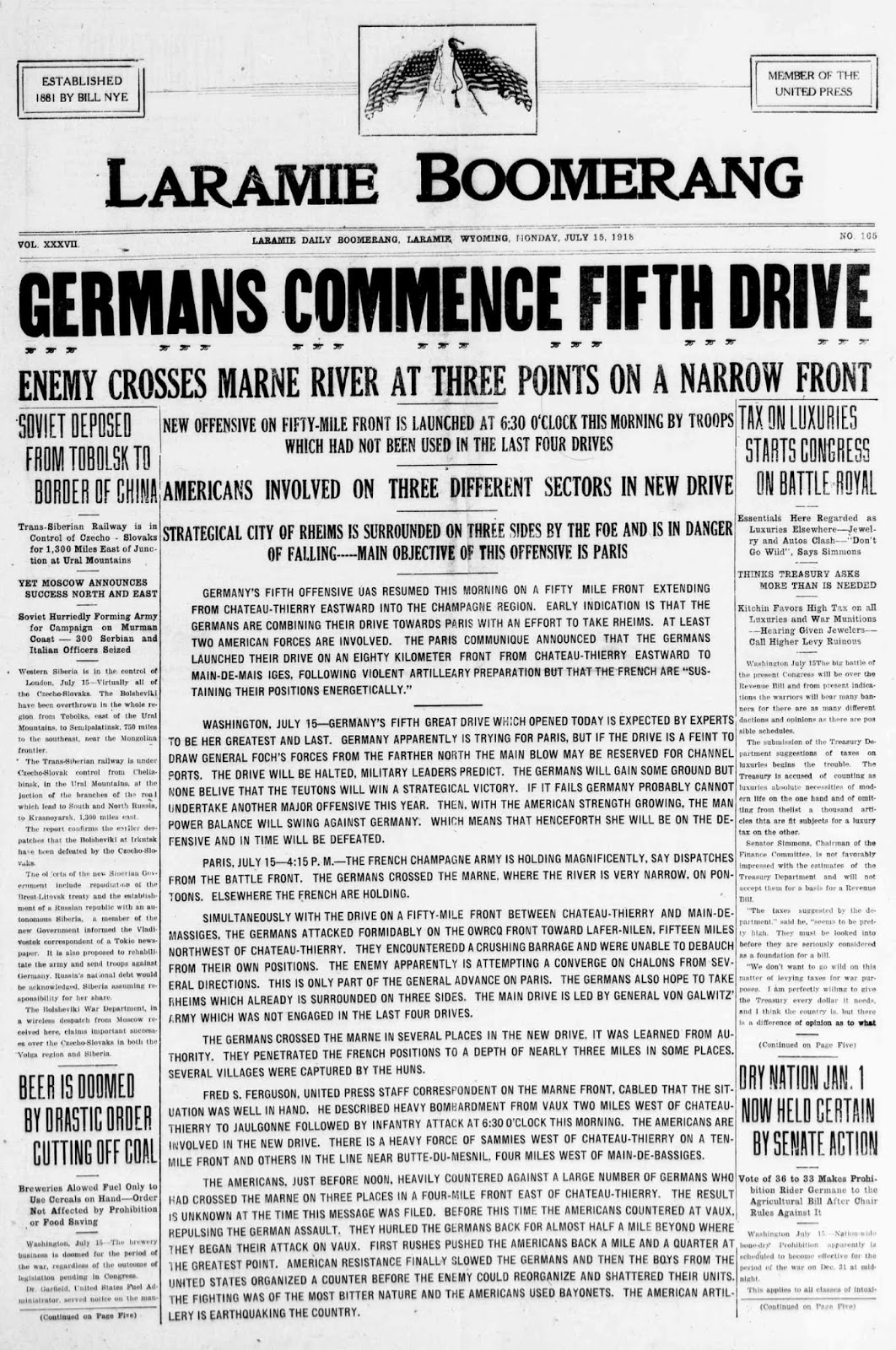Not very cheery news for a Monday. Wyoming State Tribune for Monday, July 15, 1918.
Monday, July 15, 1918, brought discouraging, if not unexpected, news.
The
map one final time, with the final German fifth drive. This time the
Germans attempted to exploit the earlier success of their drive on Paris
with a new front to the east. Over two days the effort gained ground,
but the effort was rapidly halted and by this point the French were able
to regain the initiative and counter. The Germans were effectively
blocked and gave up offensive efforts on August 7.
On
July 15 the Germans resumed offensive operations, but not the Operation
Hagen that was designed to be a final blow. Rather, they launched Friedensturm to exploit the earlier Blücher–Yorck gains.
While the offensive, like every other German offensive in this series
of operations gained ground, the French were able to ultimately
counterattack successfully and the German offensive operations came to
an end on August 7.
The final effort would see, as with the earlier efforts, some hard fighting. The Second Battle of the Marne was part of the offensive, which would run from this day until August 6. The Fourth Battle of Champaigne also started on this day. Both were launched against the French Fourth Army, the Germans having switched attention to them, of which the US 42nd Division was a part. The 42nd was a division made up of National Guardsmen. The French forces, moreover, were rapidly reinforced by British and American troops. The US 3d Division would be back in action on this day and earn the nickname "The Rock of the Marine". By the battles end eight American divisions would participate and the US would sustain 12,000 casualties. The number of divisions contributed to the defense would be twice that of the British, with American divisions being twice as large, but even embattled Italy contributed two divisions and sustained 9,000 casualties. Forty-four French divisions would fight in the battle and fifty-two German divisions.
Allied battlefield loses would be roughly equal to German ones in the campaign, but by this point the Germans did not have the troops to lose.
Laramie residents not only read about the fierce fighting in France. . . they also got to read about how coal shortages were looking to bring an end to beer.
The final effort would see, as with the earlier efforts, some hard fighting. The Second Battle of the Marne was part of the offensive, which would run from this day until August 6. The Fourth Battle of Champaigne also started on this day. Both were launched against the French Fourth Army, the Germans having switched attention to them, of which the US 42nd Division was a part. The 42nd was a division made up of National Guardsmen. The French forces, moreover, were rapidly reinforced by British and American troops. The US 3d Division would be back in action on this day and earn the nickname "The Rock of the Marine". By the battles end eight American divisions would participate and the US would sustain 12,000 casualties. The number of divisions contributed to the defense would be twice that of the British, with American divisions being twice as large, but even embattled Italy contributed two divisions and sustained 9,000 casualties. Forty-four French divisions would fight in the battle and fifty-two German divisions.
Allied battlefield loses would be roughly equal to German ones in the campaign, but by this point the Germans did not have the troops to lose.




2 comments:
I enjoy reading original sources. It's really interesting to see what the newspapers at the time said.
I do as well.
I've been quite surprised how generally accurate the WWI newspapers were. There are errors, of course, but what they got right is impressive and the degree to which they were able to predict various German offensives has been surprising.
Post a Comment